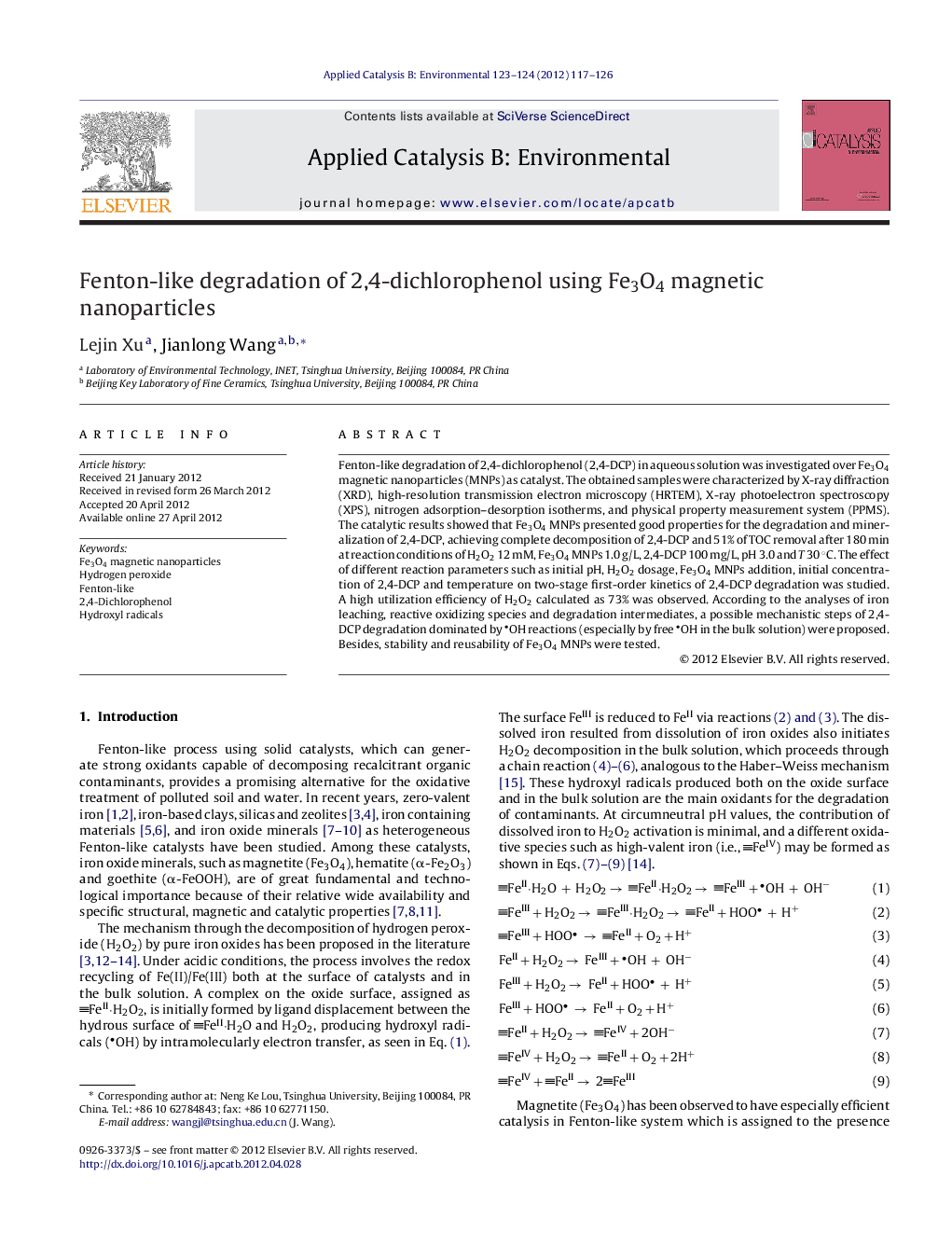| Article ID | Journal | Published Year | Pages | File Type |
|---|---|---|---|---|
| 46129 | Applied Catalysis B: Environmental | 2012 | 10 Pages |
Fenton-like degradation of 2,4-dichlorophenol (2,4-DCP) in aqueous solution was investigated over Fe3O4 magnetic nanoparticles (MNPs) as catalyst. The obtained samples were characterized by X-ray diffraction (XRD), high-resolution transmission electron microscopy (HRTEM), X-ray photoelectron spectroscopy (XPS), nitrogen adsorption–desorption isotherms, and physical property measurement system (PPMS). The catalytic results showed that Fe3O4 MNPs presented good properties for the degradation and mineralization of 2,4-DCP, achieving complete decomposition of 2,4-DCP and 51% of TOC removal after 180 min at reaction conditions of H2O2 12 mM, Fe3O4 MNPs 1.0 g/L, 2,4-DCP 100 mg/L, pH 3.0 and T 30 °C. The effect of different reaction parameters such as initial pH, H2O2 dosage, Fe3O4 MNPs addition, initial concentration of 2,4-DCP and temperature on two-stage first-order kinetics of 2,4-DCP degradation was studied. A high utilization efficiency of H2O2 calculated as 73% was observed. According to the analyses of iron leaching, reactive oxidizing species and degradation intermediates, a possible mechanistic steps of 2,4-DCP degradation dominated by OH reactions (especially by free OH in the bulk solution) were proposed. Besides, stability and reusability of Fe3O4 MNPs were tested.
Graphical abstractHeterogeneous Fenton-like degradation of 2,4-dichlorophenol (2,4-DCP) in aqueous solution was investigated over Fe3O4 magnetic nanoparticles (MNPs) as catalyst. The obtained samples were characterized by X-ray diffraction (XRD), high-resolution transmission electron microscopy (HRTEM), X-ray photoelectron spectroscopy (XPS), nitrogen adsorption–desorption isotherms, and physical property measurement system (PPMS). The catalytic results showed that Fe3O4 MNPs presented good properties for the degradation and mineralization of 2,4-DCP, achieving complete decomposition of 2,4-DCP and 51% of TOC removal after 180 min at reaction conditions of H2O2 12 mM, Fe3O4 MNPs 1.0 g/L, 2,4-DCP 100 mg/L, pH 3.0 and T 30 °C. The effect of different reaction parameters such as initial pH, H2O2 dosage, Fe3O4 MNPs addition, initial concentration of 2,4-DCP and temperature on two-stage first-order kinetics of 2,4-DCP degradation was studied. A high utilization efficiency of H2O2 calculated as 73% was observed. According to the analyses of iron leaching, reactive oxidizing species and degradation intermediates, a possible mechanistic steps of 2,4-DCP degradation dominated by OH reactions (especially by free OH in the bulk solution) were proposed. Besides, stability and reusability of Fe3O4 MNPs were tested. Figure optionsDownload full-size imageDownload as PowerPoint slideHighlights▸ Heterogeneous Fenton oxidation of 2,4-dichlorophenol using Fe3O4 magnetic nanoparticles. ▸ Fe3O4 magnetic nanoparticles show good catalytic activity and recyclability. ▸ Degradation of 2,4-dichlorophenol exhibits the two-stage first-order reaction kinetics. ▸ A high utilization efficiency of H2O2 is calculated as 73%. ▸ OH reactions (especially free OH in the bulk solution) predominate in the process.
